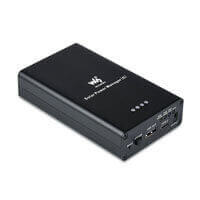- sales/support
Google Chat: zj734465502@gmail.com
- sales
+86-0755-88291180
- sales01
sales@spotpear.com
- sales02
dragon_manager@163.com
- support
tech-support@spotpear.com
- CEO-Complaints
zhoujie@spotpear.com
- sales/support
WhatsApp:13246739196
- HOME
- >
- ARTICLES
- >
- Common Moudle
- >
- Power
Solar Power Manager (C) User Guide
Introduction
The Solar Power Manager (C) is compatible with general 6V~24V solar panels. It can recharge the 18650 rechargeable Li-ion batteries through the solar panel or USB TYPE-C connection and provides 5V / 3A regulated output (with multi protocols support including PD/QC/FCP/PE/SFCP).
The module features MPPT (Maximum Power Point Tracking) function and multi-protection circuits, therefore, it is able to keep operating with high efficiency, stability, and safety. It is suitable for solar-powered, low-power IoT, and other environmental protection projects.
SAFETY CAUTION
- Li-ion and Li-po batteries are quite unstable. They may cause fire, personal injury, or property damage if they're not properly recharged or used.
- Do not reversely connect the polarities when recharging or discharging the battery. Do not use an inferior charger/charging panel to recharge the battery.
- Do not mix use old batteries with new ones, avoid using batteries of different brands.
- When buying a Lithium battery, should always make sure the battery specification is compatible with the expansion board. Choose batteries from the formal manufacturer, and ensure the batteries will work stably and safely by aging test.
- Lithium batteries have limited cycle life, they will also deteriorate as time goes by. Should be replaced with new ones when the batteries reach their max cycle life, or work over two years, whichever comes first.
- Should be placed carefully and properly, keep it away from inflammable and explosive articles, away from children, avoid any safety accident caused by careless storage.
- DO NOT put any non-rechargeable battery, like dry cell, into the battery holder. Serious consequences including explosions may occur if you try to charge a non-rechargeable battery.
Features
- Supports MPPT (Maximum Power Point Tracking) function, maximizing the efficiency of the solar panel
- Flexible battery recharging: from a solar panel or USB TYPE-C power adapter
- Compatible with 6V~24V solar panels, DC-002 jack input, or screw terminal input
- Onboard MPPT SET switch, select the level closed to input level to improve recharging efficiency
- Onboard aluminum electrolytic capacitor and SMD ceramic capacitor, reducing the ripple, stable performance
- Embedded battery holder, supports 3x 18650 rechargeable Li-ion batteries
- Several LED indicators, for monitoring the status of solar panel and battery
- Multi-protection circuits: overcharge / over-discharge / reverse-proof / overheat / over current, stable and safe to use
Specification


Capacity indicators

How to use
- Turn the switch to ON and press the BOOT button. The LEDs will turn on and indicate the capacity.
- Connect the solar panel to DC-002 or the screw terminal with the adapter. If the connection is correct, the Solar Charger indicator turns on. If you reverse the connection, the Solar Warning indicator will turn on. The Solar Done indicator will turn on if the battery is fully charged and turns off the Solar Charge indicator.
- If you connect the power adapter to the TYPE-C interface, the Quick LED indicates the fast charge mode. The LED is off if your charger doesn't support a fast charge. The indicators of capacity flashing when charging and turn off when fully charging.
- The Type-C interface can only be used for discharging, you can connect it to power other USB devices.
- USB -OUT interface can be used for powering other USB devices.
Notices:
⚫BOOT button: In fast-charging mode with Type-C interface, single-click the BOOT button and exit from fast-charging mode. ⚫If the type-C charger interface and the USB-OUT interface work at the same time, the fast-charging function is invalid. ⚫The fast charge mode can only work if the power adapter supports fast charging.
Working with Raspberry Pi
This board can be used with Solar Powering Applications for MCU and SBC like Raspberry Pi/ Jetson Nano / Arduino and so on.
If you need to change the input voltage of the solar panel, you need to take apart the case and change the setting of the DIP switch in PCBA, For example, if you want to change the voltage to 18V:





